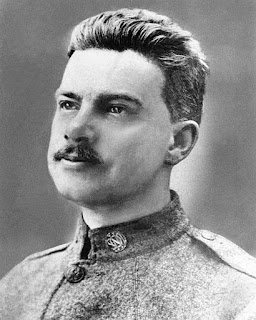 |
| How strange indeed: a 1930s mystery in the form of a narrative poem |
Who was Dorothy Bennett?* I hardly know, beyond that she was unmarried in 1935, a university graduate, a Berkeley, California native and the daughter of Mrs. Mary Richardson Bennett, to whom How Strange a Thing is dedicated. I would like to know more about Bennett, for in producing How Strange a Thing, she at least claimed the merit of doing Something That Is Not Done Every Day.
 |
| Aline Kilmer, wife of poet Joyce Kilmer (above) praised How Strange a Thing as "an excellent work of art" |
Edmund Wilson famously despised detective stories, but his former Princeton classmate Professor Whipple must have felt differently, for the latter man praised How Strange a Thing for having, among other fine qualities, "the excitement and suspense of a good detective story" (Whipple also felt it had "the verve and speed of good narrative, and the insight into people's minds of good fiction").
I am not quite as enthusiastic about Dorothy Bennett's verse mystery as the distinguished T. K. Whipple. However, I found How Strange a Thing an interesting reading experience, and it certainly has kindled my interest in the idea of mystery made in verse.
How Strange a Thing is set in San Francisco, a locale about which Bennett writes evocatively:
 | |||
| Before their feet steep Sacramento street Plunged like a rocket swiftly down to meet The dark and glittering bay. |
Stood watching it a second from Kearny's hill;
Before their feet steep Sacramento street
Plunged like a rocket swiftly down to meet
The dark and glittering bay; and sweetly sang
The night and the cool wind, the distant clang
Of little cable cars, glow-worms that crawled
From Market street up to a fog-bound world,
The foothills of the stars, and from there hurled
Themselves in haste down to earth-light again.
Earlier Danny found himself landed in a great deal of trouble.
"Danny Tiernan went up the steps of his little brown house," we are told in the first line of the poem. "Into horror."
The police are waiting for Danny to question him about a murder:
You knew a girl, we understand--a player
Of small parts in the theatre--Mary Thayer?
Mary has been stabbed to death. Danny knows he is in trouble when he gets the police warning:
On either side of him stood plain-clothes men,
One said, "We warn you--anything you say
We can use against you, from this day."
The police take Danny away to a police station for interrogation. Danny is subjected to three hours of American third degree. Fortunately, Danny's housemate Phil turns up--and Phil is a newspaper journalist:
Phil's press badge flashed to sight upon his vest.
"The stars fight for you, Danny. This is a charm.
That shall stand stout between you and all harm.
And if you think their second thought is best,
I will match star with star, and, saint, or sinner,
I will assuage you, Danny. Let's go to dinner."
 |
| Oyster stew in cream the perfect accompaniment for alibi discussions |
Danny grinned faintly. "Martini wasn't pleasant.
Just scratch him and you get original peasant."
Oh, and we learn, that Danny didn't really love Mary, but another young woman, Clare. Cue love interest!
So, who killed Mary Thayer? We do find out, and the solution has a certain interest, in terms of character study. If you are looking for a fair play mystery in the form of verse, however, forget it! I wish Bennett had shown more interest in clue placement and perhaps trimmed some of the Big Philosophizing about Death. But then I am a detection fiend!
On the whole, despite my disappointment with How Strange a Thing as a fair play mystery, I did enjoy the poem. At the very least, it is an interesting novelty, and it made me want to seek out H. R. F. Keating's effort in this field, Jack the Lady Killer.
I bet Keating gives us real clues along with the verse!
*Note There appears to be another Dorothy Bennett, a playwright and screenwriter, who was active in the 1930s and 1940s, but she does not seem to be the same Dorothy Bennett who in 1935 published How Strange a Thing and Murder Unleashed. The Passing Tramp.

You can find poetry in Agatha Christie, Raymond Chandler...
ReplyDeletehttp://wordcount-richmonde.blogspot.co.uk/2010/10/found-poetry.html
Richmonde,
ReplyDeleteYes, and P. D. James' Dalgleish is a poet! But how often are entire mystery books written in verse? Keating's Jack, the Lady Killer was the only other example that came to mind.
How long did she manage to sustain this? Page length, that is. Keating's book is very slim at 160 pages - shorter than a Simenon book, I think. I saw it in the CPL last year and didn't think I would be able to get though an experiment like that.
ReplyDeleteJohn,
ReplyDeleteIt's 96 full pages--should have mentioned that in the review. Seven "chapters."
There's also Vikram Seth's novel in verse "The Golden Gate." Also set in San Francisco, and even the dedication, the author's bio and the table of contents (!!!)fit the same form & meter as the book's poetry.
ReplyDeleteI must seek out this curiosity. When Harry Keating inscribed his verse mystery to me, he wrote: "I dare you to have a go!" But so far, I haven't dared to try it. Maybe one day...
ReplyDeleteI'd get this one just for the descriptions of San Francisco - a great find Curt, congrats! And it has to be a lot less obtuse that Getrude Stein's attempt, THE BLOOD ON THE DINING-ROOM FLOOR
ReplyDelete